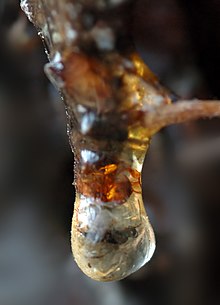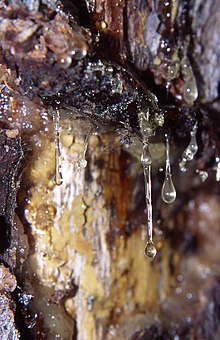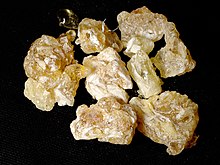Resin

In polymer chemistry and materials science, a resin is a solid or highly viscous substance of plant or synthetic origin that is typically convertible into polymers.[1] Resins are usually mixtures of organic compounds. This article focuses mainly on naturally occurring resins.
Plants secrete resins for their protective benefits in response to injury. Resins protect plants from insects and pathogens.
Composition
Most plant resins are composed of
Examples
Examples of plant resins include
Amber is fossil resin (also called resinite) from coniferous and other tree species. Copal, kauri gum, dammar and other resins may also be found as subfossil deposits. Subfossil copal can be distinguished from genuine fossil amber because it becomes tacky when a drop of a solvent such as acetone or chloroform is placed on it.[4] African copal and the kauri gum of New Zealand are also procured in a semi-fossil condition.
Rosin

Rosin is a solidified resin from which the volatile terpenes have been removed by distillation. Typical rosin is a transparent or translucent mass, with a vitreous fracture and a faintly yellow or brown colour, non-odorous or having only a slight turpentine odour and taste. Rosin is insoluble in water, mostly soluble in alcohol, essential oils, ether, and hot fatty oils. Rosin softens and melts when heated and burns with a bright but smoky flame.
Rosin consists of a complex mixture of different substances including organic acids named the
Rosin is obtained from
Petroleum- and insect-derived resins
Shellac is an example of an insect-derived resin.
Asphaltite and Utah resin are petroleum bitumens.
History and etymology

Human use of plant resins has a very long history that was documented in ancient Greece by Theophrastus, in ancient Rome by Pliny the Elder, and especially in the resins known as frankincense and myrrh, prized in ancient Egypt.[9] These were highly prized substances, and required as incense in some religious rites.
The word resin comes from French resine, from Latin resina "resin", which either derives from or is a cognate of the Greek ῥητίνη rhētínē "resin of the pine", of unknown earlier origin, though probably non-Indo-European.[10][11]
The word "resin" has been applied in the modern world to nearly any component of a liquid that will set into a hard
Some naturally-derived resins, when soft, are known as 'oleoresins', and when containing benzoic acid or cinnamic acid they are called balsams. Oleoresins are naturally-occurring mixtures of an oil and a resin; they can be extracted from various plants. Other resinous products in their natural condition are a mix with gum or mucilaginous substances and known as gum resins. Several natural resins are used as ingredients in perfumes, e.g., balsams of Peru and tolu, elemi, styrax, and certain turpentines.[5]
Non-resinous exudates
Other liquid compounds found inside plants or exuded by plants, such as
, are sometimes confused with resin but are not the same. Saps, in particular, serve a nutritive function that resins do not.
Uses
Plant resins
Plant resins are valued for the production of varnishes, adhesives, and food glazing agents. They are also prized as raw materials for the synthesis of other organic compounds and provide constituents of incense and perfume. The oldest known use of plant resin comes from the late Middle Stone Age in Southern Africa where it was used as an adhesive for hafting stone tools.[12]


The hard transparent resins, such as the copals,
Animal resins
While animal resins are not as common as either plant or synthetic resins some animal resins like lac (obtained from Kerria lacca) are used for applications like sealing wax in India,[14] and lacquerware in Sri Lanka.[citation needed]
Synthetic resins
Many materials are produced via the conversion of synthetic resins to solids. Important examples are
See also
- Amber
- Resin extraction – method of harvesting resin from trees
- Balsam of Peru – a balsam used in food and drink for flavoring, in perfumes and toiletries for fragrance, and in medicine and pharmaceutical items.
- Mastic (plant resin) – resin from the Pistacia lentiscus tree
- Pitch (resin)
- Kino (gum)– a plant gum similar to resin
- Biodegradable– plant resins are naturally biodegradable in many circumstances.
- Resin casting – casting with a resin, usually using a synthetic not a natural resin.
- Polyresin– a hard, synthetic resin for casting in molds
References
- .
- ^ "Resins". www.fs.fed.us.
- ^
"Plant Resins: Chemistry, evolution, ecology, and ethnobotany", by Jean Langenheim, Timber Press, Portland, OR. 2003
- ^ David Grimaldi, Amber: Window to the Past, 1996, p 16-20, American Museum of Natural History
- ^ ISBN 978-3-527-30673-2.
- JSTOR 4119722.
- S2CID 85842020.
- S2CID 15828725.
- ^ "Queen Hatshepsut's expedition to the Land of Punt: The first oceanographic cruise?". Dept. of Oceanography, Texas A&M University. Archived from the original on 2014-08-14. Retrieved 2010-05-08.
- ^ "resin, n. and adj". OED Online. Oxford University Press. September 2014. Retrieved 2 December 2014.
- ^ "resin (n.)". Online Etymology Dictionary. Retrieved 2 December 2014.
- PMID 26983080.
- ^ "Non-wood forest products from conifers - CHAPTER 6". www.fao.org. Archived from the original on 2015-06-19. Retrieved 2015-06-18.
- ^ "The art of sealing."
- ^ "Basics of Alkyd Resin Technology". Chemical Dynamics. 2016-03-29. Archived from the original on 2021-05-14.
